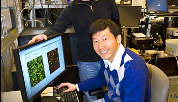Quantum dots pair with fullerenes to provide power
on

As part of ongoing efforts to engineer ever-smaller electronic devices, scientists at the U.S. Department of Energy’s Brookhaven National Laboratory (BNL) have created nanoscale assemblies of paired particles that show promise as miniature power sources. Composed of light-absorbing colloidal quantum dots linked to carbon-based fullerene nanoparticles, these two-particle systems can convert light to electricity in a precisely controlled manner.
According to BNL physical chemist Mircea Cotlet, who carried out the research together with materials scientist Zhihua Xu at Brookhaven’s Center for Functional Nanomaterials (CFN), this is the first demonstration of a hybrid inorganic/organic dimeric material that acts as an electron donor–bridge–acceptor system for converting light to electricity. The rate and magnitude of fluctuation in light-induced electron transfer at the individual dimer level can be controlled by altering the length of the bridge molecules and the size of the quantum dots. According to Cotlet, this makes these dimers promising power sources for molecular electronics or more efficient solar cells.
Scientists attempting to develop molecular electronics are very interested in organic donor–bridge–acceptor systems because they have a wide range of charge transport mechanisms and their charge transfer properties can be controlled by varying their chemistry. Recently, quantum dots have been combined with electron-accepting materials such as dyes, fullerenes, and titanium oxide to produce dye-sensitised and hybrid solar cells, in the hope that the light-absorbing and size-dependent emission properties of quantum dots would boost the efficiency of these devices. However, up to now the power conversion rates of these systems have remained quite low.
The fabrication method developed by the Brookhaven scientists allows them to precisely control particle size and interparticle distance, allowing them to study conditions for light-induced electron transfer between individual quantum dots and electron-accepting fullerenes at the individual molecule level. The assembly process takes place on a surface in a stepwise fashion to limit interactions between the components, which could otherwise combine in a variety of ways. This surface-based assembly also achieves controlled, one-to-one nanoparticle pairing.
To identify the optimal architectural arrangement for the particles, the scientists strategically varied the size of the quantum dots – which absorb and emit light at different frequencies according to their size – and the length of the bridge molecules connecting the nanoparticles. For each arrangement, they measured the electron transfer rate using single-molecule spectroscopy. They found that reducing the quantum dot size and the length of the bridge molecules enhanced the electron transfer rate and reduced electron transfer fluctuations.
Image: Brookhaven National Laboratory


Discussion (0 comments)